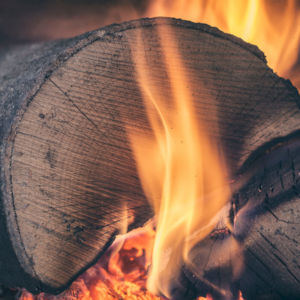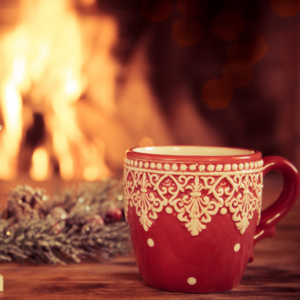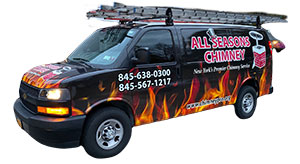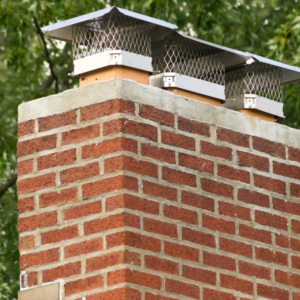Dreaming of enjoying a white Christmas as you sit by a hot, cozy fire in the fireplace? Then, we’re guessing your holiday fantasies probably don’t include a smoky, weak, or noxious fire that will drive you out into that winter wonderland. This is why knowing what to burn – and just as importantly, what not to burn – in your fireplace is crucial.
What to Burn: Seasoned Firewood
 The most important thing to keep in mind when selecting firewood is that suitable water content is key. Almost every living thing contains water, and that includes the tree your firewood was cut from. Much of this moisture must be gone before the wood will burn well.
The most important thing to keep in mind when selecting firewood is that suitable water content is key. Almost every living thing contains water, and that includes the tree your firewood was cut from. Much of this moisture must be gone before the wood will burn well.
Wood that is wet or green (newly chopped) won’t produce nice, hot fires. But the problem isn’t merely that the fire will be less warm and cozy to sit beside. The real problem is that a cooler fire will produce more smoke, more creosote, and cooler flue gases – all undesirable effects.
The solution to this problem? Well-seasoned firewood.
How Do I Know if Wood Is Seasoned?
To say that firewood is “seasoned” is to say it’s been thoroughly dried and is ready to burn. This translates to a moisture content of between 15-25%. This can be measured using a moisture meter, but using your senses can also serve you well:
- How does it look? Firewood should appear aged. The ends should look darker than if it were newly cut, the wood a paler beige color, and the sides should be noticeably cracked and split.
- How does it sound? Unseasoned wood will make a dull sound when struck against another piece, whereas seasoned wood will produce a comparatively hollow sound.
- How does it feel? Newly cut or damp wood is much heavier than seasoned firewood. If your firewood feels relatively lightweight, sounds hollow, and appears ready to use, you’re probably in good shape!
Are Hardwoods Better to Burn Than Softwoods?
It depends on what you’re looking for. Softwoods are less expensive, and they’re easier to get going in a fire because they’re less dense than hardwoods. However, this lower density also means that they generate less heat than an equivalent volume of hardwood would. Softwoods also have more sap than hardwoods, which can make them messier to handle and store. Examples of softwoods are cedar, fir, pine, spruce, poplar, redwood, balsam, and adler.
Hardwoods such as maple, walnut, ash, oak, mahogany, and most fruit trees will burn longer and hotter than softwoods once they’re lit.
Either type of wood – hard or soft – is appropriate for use in your fireplace. The question is which is more suitable to the situation. Light spring or autumn chill? Reach for your softwoods – and be prepared to feed your fire a bit more often. Cold winter night? Your denser hardwoods will give you a roaring blaze. You can also combine the two, using your softwoods as kindling year-round.
Note: Be sure to consider the type of wood if you’re paying for firewood, rather than chopping it yourself. Wood is normally sold by volume, not weight. This means that if you buy a cord of hardwood, you’re getting about twice the weight as if it were softwood. Heat production depends on the weight of your firewood, not the volume. Long story short – a cord of softwood won’t give you the same bang for your buck as a cord of hardwood. Either type is fine to use, but you should expect to fairly pay more for hardwood as it will burn longer and hotter.
What NOT to Burn
The water content of firewood matters more than the type of wood, but it is only firewood that should be burned in your fireplace. There are some wood products that should be entirely avoided when it comes to heating your home. These include:
 engineered woods (such as plywood and particleboard)
engineered woods (such as plywood and particleboard)- painted or varnished wood
- treated lumber
- driftwood
Other things that shouldn’t be burned include yard waste, such as:
- leaves and pine needles
- household waste
- cardboard
- plastic
- styrofoam
This means the aftermath of Christmas with its colored paper, packaging, and spent tree or garlands shouldn’t make its way into your fireplace. Also, while you’d use charcoal in your grill outdoors, it’s very hazardous to use in an indoor fireplace.
Why What You Burn Matters
Why should you be selective about what you burn in your fireplace?
✓ Incomplete combustion, which can be come about by insufficient airflow or improper fuel moisture content resulting in insufficient temperature, means greater production of smoke and creosote and the risk of fumes not being properly vented out of the flue.
✓ Creosote is a dark, highly combustible substance that builds up in chimneys over time but is removed by your chimney professional when you have your chimney swept. Using improper fuels accelerates the build up of creosote, putting you at much greater risk for a chimney or roof fire. Additionally, creosote is unhealthy for humans and animals.
✓ Many fuels not intended for fireplace use – such as the treated woods, waste products, and charcoal mentioned above – contain chemicals that can be released as they burn and are hazardous to respiratory health. Not least among risk factors maximized by improper burning is carbon monoxide, a colorless, odorless gas that can be fatal.
✓ Burning improper fuel can put you at greater risk for uncontained fires. Unpredictable burning may result, or lighter weight particles breaking off while still ignited can escape your fireplace or create a hazard in your chimney.
These are all hazards we work hard to minimize when we offer professional chimney inspections and sweeping by our friendly, qualified technicians. Burning anything but well-seasoned firewood puts your system – and home in general – at unnecessary risk.
Questions for Us?
Questions about how to minimize hazards and feel confident enjoying your fireplace? Remember that we’re at your service. Call us at 845-245-6787 or reach out online today.


 Chimney swifts are migratory birds that return here to the eastern United States every spring. They’re
Chimney swifts are migratory birds that return here to the eastern United States every spring. They’re  Our specialists will be sure your chimney is clear, safe, and ready for
Our specialists will be sure your chimney is clear, safe, and ready for